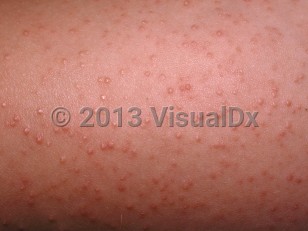Keratosis pilaris tends to worsen during winter months, and it usually decreases after puberty. It is typically asymptomatic, but if treatment is attempted, the affected areas are often refractory.
Keratosis pilaris is seen with increased incidence in several syndromes and disease states. In addition to atopic dermatitis, these include ichthyosis vulgaris, erythromelanosis follicularis faciei et colli (erythema, brown pigmentation, and keratosis pilaris), Graham-Little-Piccardi-Lassueur syndrome (cicatricial alopecia of the scalp, loss of pubic and axillary hairs, and keratosis pilaris), cardiofaciocutaneous syndrome, Noonan syndrome, diabetes, Down syndrome, woolly hair, and obesity.
Clinical Variants
- Nonatrophic variant with background erythema – keratosis pilaris rubra
- Atrophic variants – keratosis pilaris atrophicans faciei (ulerythema ophryogenes), atrophoderma vermiculatum, and keratosis follicularis spinulosa decalvans



 Patient Information for
Patient Information for 
